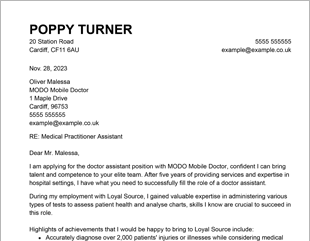Avoid the Phrase “To Whom It May Concern” on a Cover Letter
The phrase “To whom it may concern” is typically not recommended in cover letters. Why is this, and what can you use instead?
The phrase “To whom it may concern” is typically not recommended in cover letters. Why is this, and what can you use instead?





OUR USERS HAVE BEEN HIRED BY
When you’re writing a cover letter, a lot of thought will go into every phrase you use. One of the important parts of your cover letter will be the salutation—the greeting you use to address the person you’re writing the cover letter to. Many people use the phrase, “To whom it may concern,” as it might seem like an effective way to address an employer when you don’t necessarily know who’s going to read the cover letter. However, doing so is now frowned upon. Why is this a bad idea and what should you use instead? Here’s what you need to know.
“To whom it may concern” might seem like a valid, respectful way to open a business correspondence. The problem is that it actually gives a bad first impression.
“To whom it may concern” is a generic greeting, and while that might be why you’re using it, that’s also the problem. It looks old-fashioned and overly generic, and it can lead to the suspicion that you’re using the same form cover letter for every job application. When hiring managers see this phrase, they may ignore the rest of the cover letter, because it feels like you didn’t put a lot of work into it.
Now that you know it’s not a great idea to use “To whom it may concern,” what are some better alternatives? Here are a few alternatives you might want to use:
In general, your best option is going to be to find the name of the specific person to whom you’re sending the cover letter.
Remember to format the salutation correctly. If using a name, address them as “Dear Mr. [Name]” or “Dear Ms. [Name].” Make sure you insert a comma and a paragraph break after the name to set off the introduction. Capitalisation is important if you’re going with one of the options that don’t include a name. If you’re using one of these options, make sure you capitalise the job title of the person you’re addressing the letter to.
One reason people use generic phrases like “To whom it may concern” is that they just can’t find the name of the person they’re trying to contact. There are many ways you might be able to find the contact information for the individual who will be handling your application. From easiest to most involved, here are a few options:
The last option is the one that’s most likely to get results if you can’t find the name of the person handling the applications, but you may need to wait for business hours, and you’ll need to call them on the phone. Make sure you have the name of the job posting and where you found it, as some companies with many hiring openings have different managers handling different job postings.
This is as old-fashioned and generic as “To whom it may concern.” In a modern business letter, trying to include the name of a specific contact person, not just a general phrase you could attach to any letter. If you really can’t find the name of the person who will handle the cover letter, a much better option is to use one of the salutation options in this article.
Yes. When you use one of the cover letter templates in the CVHelp cover letter builder, you’ll get help with including the company name and the name of the person you’re addressing the letter to. This is one of the best ways to use a cover letter builder and it makes your cover letter look much more professional.
If there’s more than one person handling the job applications, you should still stay away from using phrases like “To whom it may concern.” Group phrases like “Dear Recruiting Department” and “Dear Hiring Team” will look better on the page. Even when you’re using it as a way to address one person in a group of people, it comes off as old-fashioned, and you’re better off using one of the group phrases showcased above.
We personalize your experience.
We use cookies in our website to ensure we give you the best experience, get to know our users and deliver better marketing. For this purpose, we may share the information collected with third parties. By clicking “Allow cookies” you give us your consent to use all cookies. If you prefer to manage your cookies click on the “Manage cookies” link below.